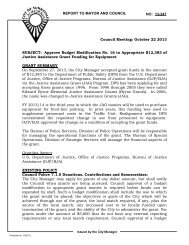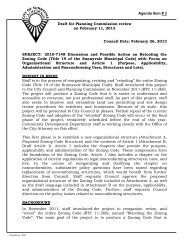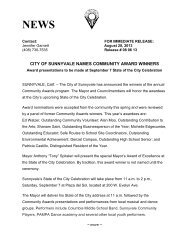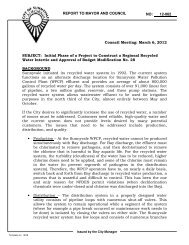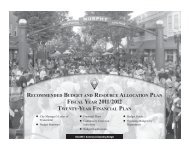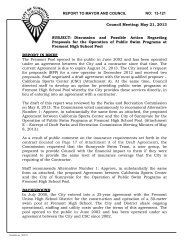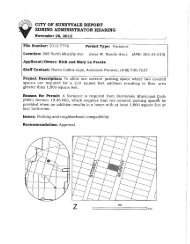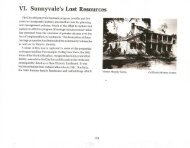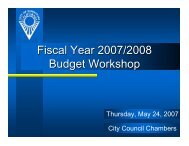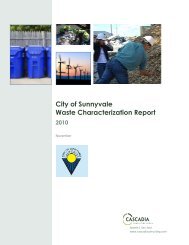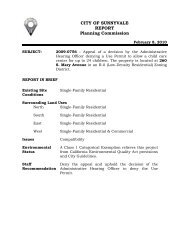700 Timberpine Avenue - City of Sunnyvale - State of California
700 Timberpine Avenue - City of Sunnyvale - State of California
700 Timberpine Avenue - City of Sunnyvale - State of California
Create successful ePaper yourself
Turn your PDF publications into a flip-book with our unique Google optimized e-Paper software.
Initial Study Checklist<br />
Project Name: <strong>700</strong> <strong>Timberpine</strong> <strong>Avenue</strong><br />
File #2010-7672<br />
Page 11 <strong>of</strong> 31<br />
The report dated April 11, 201 1 discusses existing noise conditions at the site as well as applicable SMC<br />
noise standards and thresholds.<br />
The study measured noise levels at four locations surrounding the property. Existing noise levels were<br />
measured at levels between DNL 60 dBa and DNL 64 dBa. To account for future traffic volumes <strong>of</strong> 1-2%,<br />
IdB was added to the measured DNL. A future DNL <strong>of</strong> up to 65 dB is expected for the exterior noise<br />
level. This level is considered conditionally acceptable by the <strong>City</strong> Noise Sub-Element. In order to meet<br />
the <strong>City</strong>'s goal <strong>of</strong> 60 dB, a six foot tall noise barrier is necessary for the rear yards <strong>of</strong> the proposed homes<br />
on Lily <strong>Avenue</strong> and the house on the northeast corner <strong>of</strong> the project site on Dahlia at Toyon <strong>Avenue</strong>. This<br />
will reduce this impact to less than significant.<br />
An interior noise level above 45 dB is also expected to occur in the living spaces. The noise report<br />
recommends typical dual-pane windows (STC 26-28 minimum) and standard frame construction. The<br />
report also recommends mechanical ventilation <strong>of</strong> the units to provide for a habitable interior environment<br />
when the windows are closed to shield noise. This will reduce this impact to less than significant.<br />
To achieve this reduction the following mitigation measures are needed required:<br />
WHAT: 1) A six foot tall noise barrier shall be constructed at the rear yards <strong>of</strong> the homes on Lily<br />
<strong>Avenue</strong> and the house on the northeast corner <strong>of</strong> the project site on Dahlia at Toyon<br />
<strong>Avenue</strong>s. This barrier, as described the Salter 2011 report, must be solid from top to<br />
bottom, have no surface gaps or cracks, and must be a minimum <strong>of</strong> three pounds per<br />
square foot. The wall may be masonry, CMU block, or enhanced wood.<br />
2) To achieve compliance with the 45 dB interior noise level standard, Sound<br />
Transmission Class minimum rated 26-28 windows shall be installed near all living<br />
spaces.<br />
3) All units shall have a ventilation or air-conditioning system that provides habitable<br />
interior environments.<br />
WHEN: These mitigation measures shall be converted into conditions <strong>of</strong> approval for the SDP<br />
prior to its final approval by the <strong>City</strong>'s Planning Commission. The building plans will<br />
reflect the noise attenuation measures identified above prior to conditions will become<br />
valid when the SDP is approved and prior to Building Permit issuance. All mitigation<br />
measures must be installed prior to Building Permit final.<br />
WHO: The property owner (developer) will be solely responsible for implementation and<br />
maintenance <strong>of</strong> these mitigation measures.<br />
HOW: The conditions <strong>of</strong> approval will require these mitigation measures to be incorporated into<br />
the construction plans.<br />
14. Noise (Less than Significant with Mitigation) - Construction Impacts: The first phase <strong>of</strong><br />
construction <strong>of</strong> the project would occur over an approximate two and one-half year period, followed by<br />
the future construction <strong>of</strong> the remaining four lots in the second phase. Grading intensive activities would<br />
last 10 to 14 weeks. Noise generating activities would include grading, the establishment <strong>of</strong> utilities,<br />
construction <strong>of</strong> streets, construction <strong>of</strong> 51 new homes, and landscaping. Pile driving or other ground born<br />
vibrations are not an anticipated during construction.<br />
Noise impacts resulting from construction depend on the noise generated by various pieces <strong>of</strong><br />
construction equipment, the timing and duration <strong>of</strong> noise generating activities, and the distance between<br />
construction noise sources and noise sensitive receptors. Construction noise impacts primarily result



